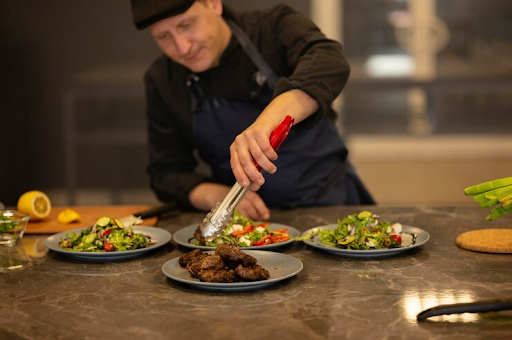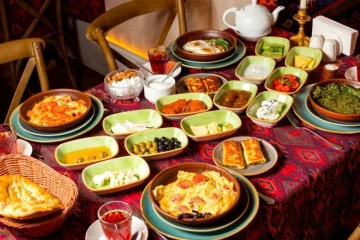Have you ever wondered what happens in a chef’s mind when they create a dish that makes you savor every bite?
Creating new dishes is a blend of creativity, science, and a deep understanding of flavors. It involves experimenting with ingredients and techniques, balancing flavors, and perfecting presentation.
Chefs meticulously refine their creations through feedback, staying ahead of culinary trends to offer innovative dining experiences.
In this blog post, we’ll explore a step-by-step guide on how private chef in Atlanta create unforgettable dishes. We’ll also survey chefs’ journey to transform inspiration into culinary masterpieces, from the initial spark of creativity to the final, beautifully plated dish.
Step 1: Taste Everything and Build a Flavor Bank
An experienced chef or aspiring culinarian builds a familiarity with a wide range of flavors into their flavor bank. In short, the more you know about flavors, the more you can create new dishes.
A flavor bank helps differentiate relationships between flavors and generate new ways to combine them. Therefore, taste everything and understand different textures and flavors. This will broaden your taste knowledge.
This way, you can experience different flavors and replicate them in your kitchen. Once you find the correct one, you will add that to your culinary techniques.
Sep 2: Check the Raw Item Before Starting to Cook
A chef must check the smell or taste of raw items before they start to cook. For instance, when making a sauce, you must smell carrots and onions as they soften.
Once the vegetables are entirely sweated, taste the flavor. This will help you understand the taste, easily incorporate ingredients, and make new dishes.
Step 3: Create a List of Ingredients
Make a list of ingredients you need to use or those you haven’t used. Get inspiration from your surroundings, check out magazines, and be influenced by different cultures.
Step 4: Time to Hone Techniques and Start Experimentation
After gaining knowledge, it’s time to implement it in the kitchen. Chefs create new dishes while combining different flavors, cooking methods, and ingredient pairings. This process includes a lot of practice, trial and error, and repetition of a dish before perfecting the final dish.
Step 5: Focus on the Texture and Presentation
Beyond flavor, chefs also enjoy focusing on the texture and presentation of their dishes. The texture adds another layer of complexity, with contrasts between crispy and creamy or tender and crunchy. It makes each bite a delightful experience.
Presentation, on the other hand, is about engaging the visual senses. A beautifully plated dish elevates the dining experience, turning a meal into a work of art. Chefs use colors, shapes, and arrangements to create visually stunning plates that entice diners even before having the first bite.
Step 6: Give the Final Touches and Get Feedback
After developing a dish, chefs seek feedback from their peers and diners. This is crucial, providing insights or perspectives the chef might have overlooked. Constructive criticism helps refine the dish and turn it to meet the highest standard of taste and presentation.
Based on this feedback, chefs might tweak the seasoning, adjust the cooking time, or reimagine the plating. The goal is to perfect the dish, making it ready to be introduced to the menu and enjoyed by a wider audience.
Step 7: Always Staying Ahead of Trends
Innovation is key in the ever-evolving culinary landscape. Chefs constantly strive to stay ahead of trends, incorporating new techniques and ingredients into their repertoire.
This might involve embracing molecular gastronomy, experimenting with plant-based alternatives, or exploring sustainable and locally sourced ingredients.
The culinary world is potent. Hence, chefs should adapt and evolve to maintain relevance. They can do this by simultaneously pushing the boundaries of creativity and innovation. Chefs ensure their dishes remain groundbreaking and delicious.
Innovative Cooking Techniques
To create a new dish, the chef must follow new cooking techniques that exquisitely enhance the dish and make it memorable.
Modernist Methods
The culinary world constantly evolves with new techniques that open up endless possibilities for creativity. Techniques like sous vide, molecular gastronomy, and anti-griddles allow chefs to manipulate textures and flavors in previously unimaginable ways.
These methods enable chefs to achieve precise results and push the boundaries of traditional cooking.
Traditional Techniques Revived
Conversely, some chefs find inspiration in reviving and adapting old-world techniques. This approach often leads to a rediscovery of forgotten flavors and methods. It provides a nostalgic yet novel eating experience that resonates with contemporary palates.
Cook What Inspires You
When it comes time to develop a new dish, chefs draw inspiration from various sources, for example:
Leverage Your Culinary Memory
Adhering to classic recipes is not necessary. Revisit your personal method, go to culinary food experiences, and leverage your flavor memory to create new dishes. In this way, you can reinvent a dish with the help of your traditional method.
Seek Out Benchmarks
Studying recipes and dishes from other chefs, whether in cookbooks or at restaurants, provides a helpful reference point. Chefs may aim to create their own interpretation of a beloved dish.
Respond to Availability
Seasonal ingredients or special product deliveries can spark culinary creativity. Chefs may design new dishes around what’s fresh and abundant.
Conclusion
Creating new dishes is a complex interplay of inspiration, technique, experimentation, and storytelling. Chefs are artists, constantly learning and evolving, pushing culinary boundaries, and redefining what food can be.
Each new dish offers a glimpse into the mind of its creator, inviting diners to explore new flavors, textures, and culinary possibilities.
Creating new dishes is a journey that transcends the simple act of eating, transforming meals into experiences that linger in the memory long after the last bite.



